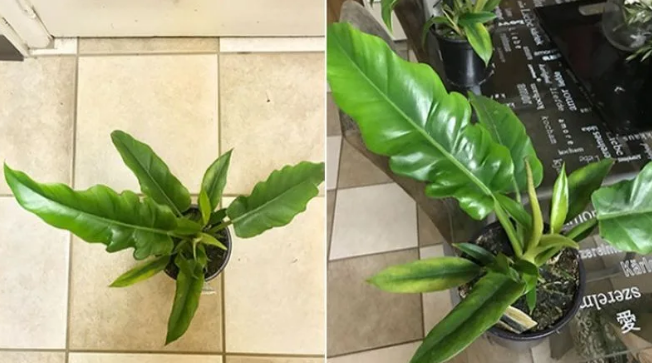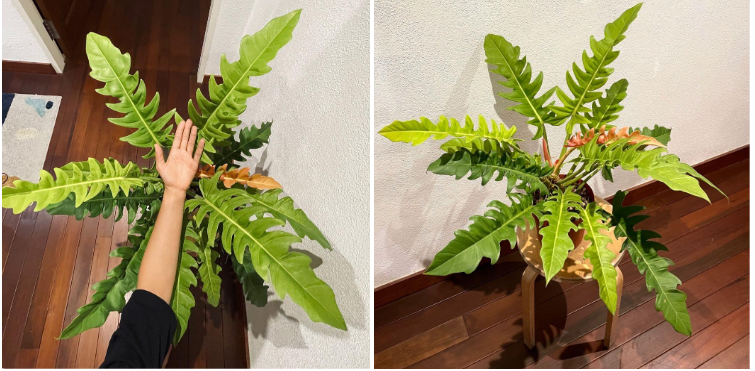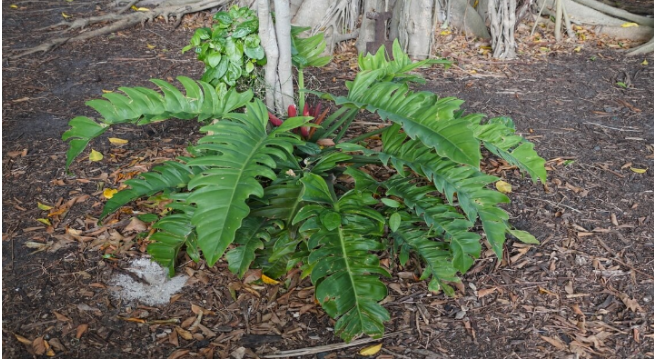The origins of the Philodendron, a popular and diverse genus of tropical plants, can be traced back to the lush rainforests of Central and South America. The name “Philodendron” is derived from the Greek words “philos,” meaning “love,” and “dendron,” meaning “tree,” reflecting the affectionate way these plants have been embraced by botanists and plant enthusiasts worldwide.
Philodendron genus has over 450 named cultivars. Philodendron Jungle Boogie is an easy to identify because, the leaves have undulating margins and is occasionally referred to as “Sawtooth” due to this feature. This philodendron is easy to care for and is adaptable to different conditions. Both beginners and experienced plant gardeners usually cultivate it with easy.
How Does Philodendron Jungle Boogie Look Like?
Scientific name: Philodendron Narrow Synonyms: Philodendron Jungle Boogie, Philodendron Narrow Tiger Tooth, Philodendron Narrow Green, Sharks Tooth.
The “Philodendron ‘Tiger Tooth’” or “Philodendron ‘Narrow Escape’ also referred to as philodendron Jungle Boogie has solid colored green leaves which resembles the teeth of a tiger due to the serrated or jagged edges. These plants can grow to be several feet tall with leaves that range from 6 inches to 26 inches in length. Smaller Philodendrons Jungle Boogie are often used as tabletop or hanging basket plants and can be well-suited for indoor gardening.
This climbing plant grows vertically when provided with a supportive pole or stake. When allowed to climb or trail, their vines can extend several feet or even longer, while individual leaves may be relatively smaller. As an indoor plant you will likely see maximum growth around 2-3′.

Philodendron Jungle Boogie or Tiger Tooth Philodendron. (Photo by Heidi Ng)
Best Uses of Philodendron Jungle Boogie
Philodendron Jungle Boogie can be used in various ways to enhance your outdoor and indoor living spaces.
- Air Purification: They can help remove pollutants and toxins from the air, such as formaldehyde and benzene.
- Natural Room Dividers: Their broad, tropical leaves can provide privacy or separate different living spaces within an open floor plan.
- Home Office Greenery: Placing a Philodendron Jungle Boogie in your home office or workspace promotes a calming and stress-reducing atmosphere, which can enhance productivity and concentration.
- Bathroom Beautification: Their lush green foliage can add a spa-like ambiance to your bathroom space. Just ensure they receive adequate indirect light and occasional misting.
- Gifts and Presents: Philodendrons are excellent gifts for plant enthusiasts or people who are new to gardening. They can be present for birthdays, housewarmings, or other special occasions.
How To Grow And Care For Philodendron Jungle Boogie
To successfully grow and care for this plant, you’ll need to provide the right environment, watering, lighting, and maintenance. Here are some tips to help you care for your Philodendron Jungle Boogie:
Light
Philodendron Jungle Boogie thrives in bright, indirect light. In its natural habitat, it grows beneath the canopy of taller trees, receiving filtered sunlight. Mimicking these conditions in your home is essential for its well-being.
While this plant enjoys bright light, it’s important to protect it from direct sunlight. Exposure to harsh, direct sunlight can scorch and damage the leaves. If you place your Jungle Boogie near a window, ensure it receives filtered or diffused sunlight, or use sheer curtains to diffuse the light.
To ensure even growth and prevent the plant from leaning or reaching toward the light source, periodically rotate your Jungle Boogie. This promotes balanced growth and helps maintain an attractive, bushy shape.
Soil
These plants are native to tropical rainforests, where they grow in well-aerated soils with good drainage. A high-quality potting mix that retains some moisture while allowing excess water to escape is ideal. You can either purchase a commercial potting mix designed for aroids or create your own by combining components like peat moss, perlite, and orchid bark.
Philodendron Jungle Boogie prefers slightly acidic to neutral soil with a pH range between 6.0 and 7.0. Maintaining the correct pH ensures that the plant can access essential nutrients and minerals from the soil, promoting healthy growth and vibrant foliage.
It is also a good practice to add organic matter to the soil. This can be accomplished by incorporating well-rotted compost or aged manure. Organic matter not only enriches the soil with nutrients but also enhances its texture.

Image Credit: Carousell.com
Temperature
Philodendron Jungle Boogie thrives in temperatures ranging from 65°F to 80°F (18°C to 27°C). This range closely resembles the warm and tropical conditions found in its native regions, such as the rainforests of Central and South America.
While Jungle Boogie can tolerate occasional fluctuations in temperature, it’s crucial to protect it from extreme conditions. Avoid exposing the plant to temperatures below 50°F (10°C), as it is sensitive to cold and can suffer damage or even die if subjected to frost or prolonged cold spells.
In the summer, make sure to protect your Philodendron Jungle Boogie from direct sunlight, especially during the hottest part of the day. While it requires bright, indirect light, too much direct sun can scorch its leaves.
Humidity
While precise humidity levels can vary, maintain humidity levels between 50% and 60% for Philodendron Jungle Boogie. This range helps prevent issues like dry leaf edges, browning, and stress that can occur in low-humidity environments.
To provide the necessary humidity for your Jungle Boogie, consider the following:
- Use a humidity tray: Place a tray filled with water and pebbles near the plant. As the water evaporates, it raises the humidity around the plant.
- Use a room humidifier: An electric humidifier can help maintain consistent humidity levels in the room.
- Group plants together: Grouping several plants together can create a microclimate with higher humidity due to the combined transpiration of water from plant leaves.
- Regular misting: Mist the foliage of your Philodendron Jungle Boogie with room-temperature water regularly, especially during dry periods.
Watering
Overwatering or underwatering can lead to various problems, so it’s essential to understand the plant’s watering needs and how to provide the right moisture levels.
Before watering, always check the moisture level of the soil. Stick your finger about an inch or two into the soil. If it feels dry at this depth, it’s time to water. If it still feels slightly moist, it’s best to wait a bit longer before watering.
When you do water, make sure to water thoroughly. This means watering until water starts to drain from the pot’s drainage holes. This ensures that the entire root system receives moisture and helps flush out any accumulated salts from fertilizers.
Use room-temperature water that has been allowed to sit for a day or two to dissipate chlorine and fluoride, which can be harmful to the plant. Avoid using water that is too cold or contains too many minerals, as this can harm the roots over time.
In general, Philodendron Jungle Boogie prefers to dry out slightly between waterings. Typically, you may need to water every 1-2 weeks during the growing season (spring and summer) and less frequently in the winter when the plant’s growth slows down.
Fertilization
Use a balanced, water-soluble houseplant fertilizer with a ratio like 20-20-20 or 10-10-10. Alternatively, you can opt for a specialized liquid fertilizer formulated for tropical or foliage plants. These fertilizers provide the necessary macronutrients (nitrogen, phosphorus, and potassium) along with micronutrients that your Jungle Boogie requires.
During the growing season, which spans from spring through early summer, you should fertilize your Philodendron Jungle Boogie regularly. Depending on the type of fertilizer you use, feeding the plant every 4-6 weeks is a good general guideline. Reduce or stop fertilization during the dormant winter months when the plant’s growth slows down.
Apply the diluted fertilizer directly to the soil during the watering process. Water-soluble fertilizers are easily taken up by the plant’s roots when dissolved in water. Avoid getting fertilizer on the foliage, as it can lead to leaf burn.
Potting And Repotting
The most common reason to repot your Philodendron Jungle Boogie is when it becomes root-bound. You’ll notice this when the plant’s roots have filled the pot to the point where there is little room for new growth, and the roots may start circling the pot.
How to Repot
- Select a new pot that is one size larger than the current one. Ensure it has drainage holes to prevent waterlogging. Philodendrons prefer being slightly root-bound, so don’t go too large with the new pot.
- Add a layer of fresh potting mix at the bottom of the new pot. The mix should be well-draining and suited for aroids like Philodendron Jungle Boogie.
- Carefully remove the plant from its current pot. You may need to tap the pot’s sides or use a gentle twisting motion to loosen the root ball. Be cautious not to damage the roots.
- Examine the roots for any signs of rot or disease, and trim away any damaged or unhealthy sections using clean, sharp pruning shears or scissors.
- Place the plant in the center of the new pot and add fresh potting mix around it, filling in the gaps. Ensure that the top of the root ball remains at the same level as it was in the old pot.
- After repotting, water the plant thoroughly to settle the soil and hydrate the roots. Allow excess water to drain from the pot.
- After repotting, your Philodendron Jungle Boogie may experience some transplant shock. Keep it in a stable, bright, indirect light location, and reduce watering for a few days to minimize stress. Resume your regular care routine once the plant has acclimated.
- Repotting is typically necessary every 2-3 years, but it depends on the growth rate of your plant and the pot size. Monitor the plant’s growth and the condition of the potting mix to determine when it’s time to repot again.
Support
Proper support helps your plant thrive and maintain its attractive appearance.
- Trellis or Stake: Philodendron Jungle Boogie is a climbing plant, and it naturally seeks out support to grow vertically. You can use a trellis, stake, or bamboo pole to provide the necessary structure for the plant to cling to as it grows. Position the support in the pot near the plant, and as it grows, gently guide the vines onto the support structure.
- Training: As the Philodendron Jungle Boogie grows, periodically train its vines to follow the support. This helps maintain an organized and attractive appearance. Be gentle when adjusting the vines to avoid damaging them.
- Ties or Clips: To secure the vines to the support structure, you can use soft plant ties or clips. These prevent the plant from falling or becoming tangled and ensure it grows in an upright manner.
Propagation

Propagating Philodendron Jungle Boogie can be an enjoyable way to create new plants and expand your collection. This unique philodendron variety can be propagated successfully through stem cuttings. Here’s a step-by-step guide on how to propagate your Philodendron Jungle Boogie:
- Choose a mature Philodendron Jungle Boogie plant with healthy, disease-free stems. Look for stems that are long enough to provide several inches of cutting material.
- Use clean and sharp scissors or pruning shears to take a stem cutting. Make the cut just below a leaf node, which is the small bump or nub on the stem where leaves and branches emerge. Each cutting should be around 4-6 inches in length and have at least one or two leaves.
- Trim away the lower leaves, leaving only a couple of leaves at the top of the cutting. This reduces the risk of excessive moisture loss through transpiration.
- Allow the cut end of the cutting to air dry for about an hour. This helps prevent rot when the cutting is planted.
- Fill a small pot or container with well-draining potting mix. Make a small hole in the soil with a pencil or your finger, and insert the cut end of the Philodendron Jungle Boogie cutting into the hole.
- Water the cutting thoroughly to settle the soil and provide initial moisture. Allow excess water to drain from the pot.
- To create a humid environment for the cutting to root, cover the pot with a clear plastic bag or plastic wrap. Secure the plastic with rubber bands or twist ties, creating a mini greenhouse effect.
- Put the potted cutting in a location with bright, indirect light. Avoid exposing it to direct sunlight, as this can scorch the cutting.
- Check the cutting regularly to ensure that the soil remains consistently moist but not waterlogged. Mist the cutting or lightly water it as needed to maintain humidity within the plastic cover.
- After several weeks to a few months, you should see roots developing in the potting mix. Once the cutting has established a sufficient root system, you can remove the plastic covering.
- Once the cutting has grown into a healthy plant with a well-established root system, transplant it into a larger pot with a standard philodendron care routine.
Common Problems
- Stagnant Growth: If you observe that your Jungle Boogie’s growth has slowed down significantly, and it’s not responding to regular care, it may be a sign that it has outgrown its current pot and needs more space for its roots to expand.
- Potting Mix Depletion: Over time, the potting mix can break down and lose its ability to provide nutrients and proper drainage. Repotting allows you to refresh the soil and provide your plant with a more suitable growing medium.
- Leaf drop or drooping of leaves happens when the plant is thirsty and has not received water for quite some time. A quick watering would solve the problem but do not let the plant reach this stage as constant droopiness can make the plant weak.
- Brown crisp patches:As much as your Philodendron Jungle Boogie loves bright light, too much direct sunlight can leave your leaves looking dull and washed out. Direct sunlight can also burn the foliage leaving unsightly brown patches on the leaves. Monitor the light around your Philodendron, if it is harsh, relocate your plant to a bright but sheltered spot.
- Pests:Pest problems are uncommon with Philodendron Jungle Boogie, however, stressed houseplants can be susceptible to pest infestations leading to excessive yellowing fronds and leaf drop. Mealybug, scale and spider mites are common indoor plant pests and can weaken your plant relatively quickly if left untreated. Adjust environmental stressors for your house plant and treat infestations with an organic pesticide.
- Small leaves:Your boogie may not be getting enough light. If the leaves are deep green and your plant has small leaves, this is a clear indication of a lack of light. Philodendron Jungle Boogie prefers medium to bright light to thrive, so if your plant is not performing well it is best to relocate to a brighter spot.